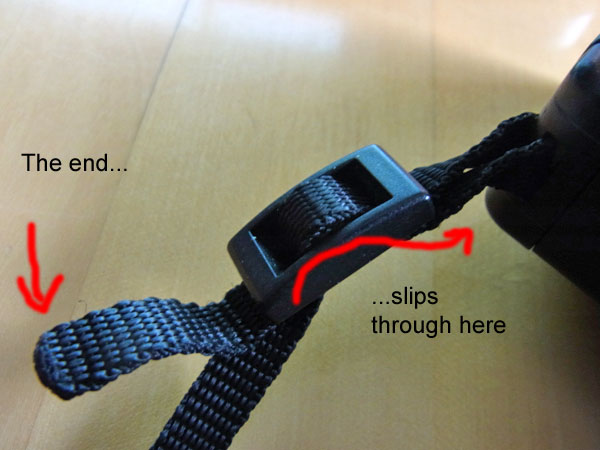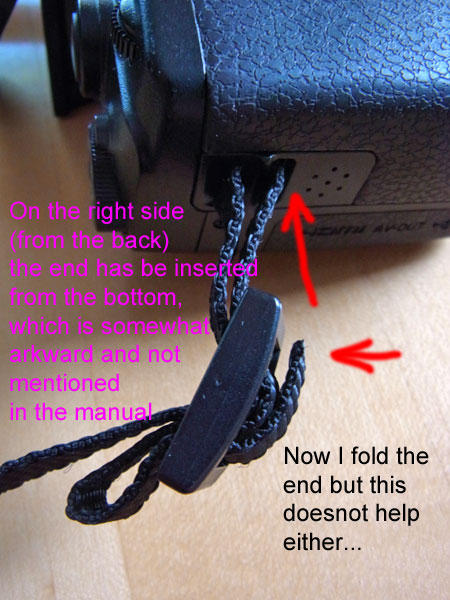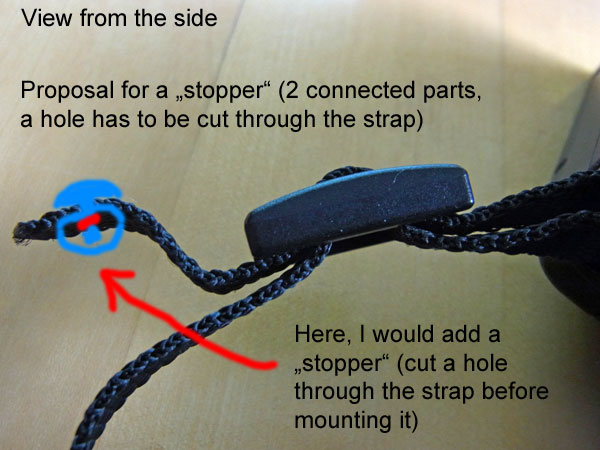Ricoh GXR: Experiences - Part 1
Look, Feel, and Weight - Pocketability? | LCD and Viewfinder | Menu System | Robustness | Robustness (2) | Preliminary Conclusions
Archive
On this page, I collect my initial Ricoh GXR experiences that I had published on the Internet (before firmware update 1.17).
Note: I collect further experiences regarding autofocus speed on a separate page.
Look, Feel, and Weight - Pocketability?
The GXR looks definitely "professionally," not like a consumer camera - I presume that there will never be a pink version of the GXR... The GXR feels rather solid and quite a bit heavy, particularly when equipped with the A12-50 camera unit and the EVF-2 viewfinder.
I would not call the GXR a beauty, but in my opinion it is also not ugly; it reminds me somewhat of analog viewfinder cameras (but does not have an optical viewfinder...). It's easy to hold with the right hand (although it feels "heavy" and may strain your hand), but initially I had some problems with placing my right thumb - the camera back is rather crowded. In the meantime, I feel more comfortable with it.
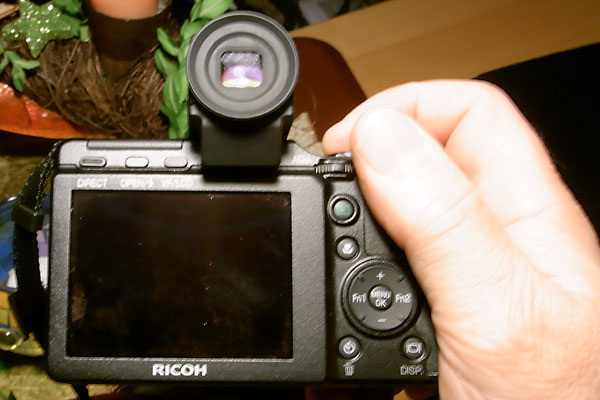 |
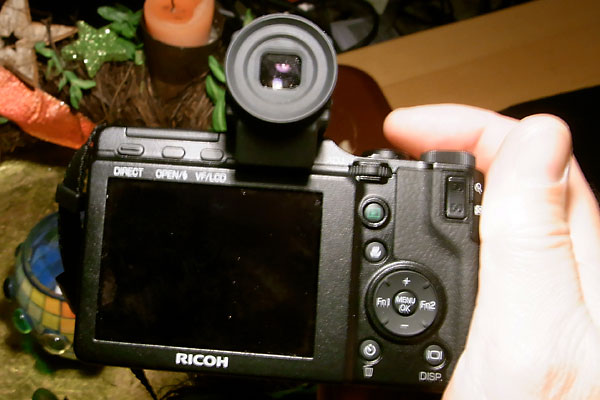 |
Photos: Two attempts showing the back having my wife's CX1 in my left hand...
The GXR does not have a "GX300" feeling for me with S10 camera unit attached, though: it appears bigger, particularly higher, but as I sold my GX200 I can no longer compare them... With the A12-50 camera unit and the viewfinder attached, the GXR reminds me more of a small DSLR, which in some respects comes close to the truth. This is much more so with the M-mount expansion unit and an M-mount lens attached.
Now from "feelings" to data - at least the weight can be measured. Our scales tell us the following (which should be true to plus/minus 10 percent):
- GXR-S10, EVF-2, LC-2, battery, SD card, shoulder strap (the one that came in the box): 407g
- GXR-S10, LC-2, battery, SD card, shoulder strap (the one that came in the box): 381g *
- GXR-A12-50, EVF-2, lens cap, battery, SD card, shoulder strap (the one that came in the box): 515g
- CX1, battery, SD card, wrist strap (our own strap), for comparison: 204g
*) I did not have the protector for the flash hot shoe available. Also subtract the weight of the shoulder strap and add the weight of a wrist strap - should be around 350g.
Thus, the "GX300" comes at nearly exactly double the weight of the CX1. That's quite a lot!
There has been a lot of discussions regarding the pocketability of the GXR. This is, in my opinion, a decision that depends largely on personal preferences and habits:
- the size of your pockets
- how heavy a camera can be in a pocket - what do you find acceptable, and what not
- which pocket you are referring to (trouser, shirt, coat, ...)
As I never carried my GX200 with attached viewfinder in my pockets, I will not carry the GXR in my pockets either (exception: when wearing a coat). Thus, all in all, I would not call the GXR a "pocketable" camera. For my GX200, I used Ricoh's SC45 case connected to a strap around my neck. I will not buy a new case for the GXR and will just use the shoulder strap for carrying it. I own a larger bag for carrying further equipment when I think that I will need it. When wearing a coat, I can put the unused module into a coat pocket (as I did today). So, I will look like a typical tourist when using the GXR! However, that should not be an issue for me, because I do not have any plans for engaging in street photography...
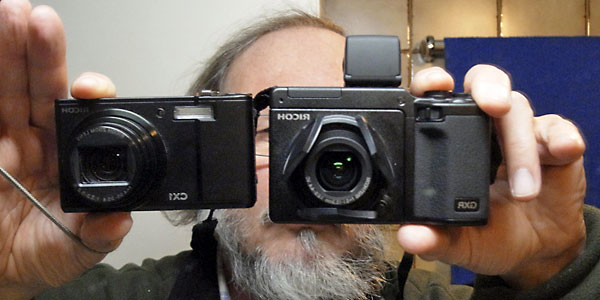 |
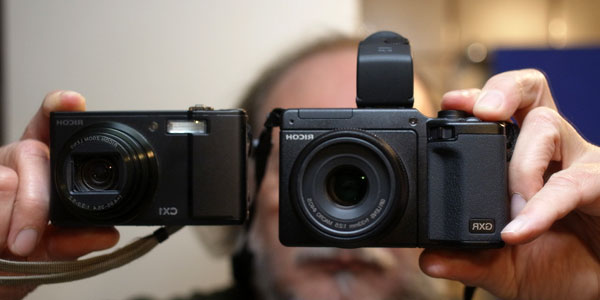 |
Photos: Size comparisons between CX1 and the GXR with S10 camera unit (left) and A12-50 camera unit (right) (click images for larger versions)
LCD and Viewfinder
The LCD screen on the back of the camera offers a high resolution of nearly one million pixels (however, one pixel for each primary color, meaning that it's actually a VGA resolution). It seems to be the same screen as the one that is being used in the CX series, and I knew it already from my wife's CX1. However, coming from an SLR tradition and being far-sighted, I always preferred electronic viewfinders over LCD screens. Moreover, pressing the camera against your forehead stabilizes the camera, thus avoiding camera shake. In addition, I prefer to have a preview of the exposure in the viewfinder and also to see the result immediately after the photo has been taken. When using my DSLR, I always forgot to check the exposure on the LCD screen (which was somewhat cumbersome for me, because I had to put glasses on, etc.). I am well aware that there are different opinions about this topic. Street photography, for example, is better done with the LCD screen - but I myself would never buy a camera that offers only an LCD-screen on the back.
Therefore, the interesting question for me was (and I was asked this already in a forum): How good is the electronic viewfinder? Once again, I cannot offer an "objective" answer. I can only say: It is much better than all the EVFs that I have used in the past, and I like it a lot. Here are a few characteristics of the EVF-2:
- Pixels are nearly invisible (should be even better in the new Olympus Pen2, Panasonic, and Sony viewfinders...)
- It is possible to focus manually with the EVF - at least under normal conditions - although not easy
- There is some grain when it is getting dark, but in an optical viewfinder you may see nothing
- Speed regarding camera moves and moving objects seems to be OK - up to now I did not find any noticeable or annoying delays
- Visibility in bright light (updated in May 2010): Not good, as long I do not use my hand to shelter my eye from the sun light (valid for spring to autumn...). A better eye cup would help a lot...
- The image is not as large as in a DSLR, but I have been told that some entry-level DSLRs have lousy optical viewfinders (my Sony A700 had a very good one!)
When I tested the GXR in macro mode and took close-up photos, I found that the EVF view was somewhat "wobbly" - I can provide no better description for this effect here. As I could not hold the camera steady, the objects were moving around in the viewfinder and showed this "wobbling" effect - probably due to some delays when the camera was refreshing the display.
All in all, the EVF is still far away from a good optical viewfinder, but it also has advantages such as exposure preview or the ability to display grid lines (but this is a general advantage of EVFs, not one specific to Ricoh's EVF-2). So, should you buy the EVF-2? If you worked primarily or exclusively with the LCD screen in the past, I would say no. You will have a lighter and more compact camera without the EVF-2 and you will also save some money. For all others, I would say yes.
Addendum: In the meantime (as of end of 2011), other manufacturers have built better viewfinders with higher resolution into their cameras, particularly Sony (Nex5N, Nex7). Many GXR users are eagerly awaiting that Ricoh will use them as well.
Menu System
The GXR menu system is similar to other Ricoh cameras and seems to come closest to the CX series (because of the same screen resolution). I had some initial issues with setting the correct image size, because I did not understand the captions on the screen, but now I know that I have to use "L"! Some testers called the CX menu system"dull" because it does not have any funny icons. I am glad that there are none!
I like the direct menu - my Sony A700 had a similar menu - but I still forget to use it: It's too new for me (on a Ricoh)! There is another advantage of the direct menu: I can see it without glasses on the LCD screen.
Robustness
In September 2010 (Sep 20), my GXR with attached P10 camera unit and LC-2 lens cap survived a drop with only a few minor scratches remaining (now, I can't sell it anymore…) during a mountain hike in Southern France on Mount Meygal (Pay de Suc, Haute Loire).
The neckstrap got loose on one side, and the camera fell down on the rocks (perhaps about 1m) and rumbled further uphill for about 2m. As the rock was oblique, the bounce was probably watered down. Luckily, the camera was off, and thus the lens protected.
I was completely shocked for the whole evening (only a few glasses of red wine helped a little)! Anyway, both the body and the P10, are still going strong!
Here is about the location, where the camera dropped (Mount Meygal):
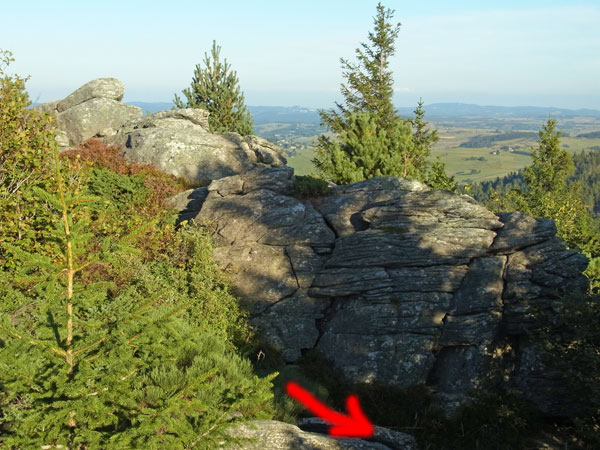
And this is the view from the Meygal that I had before the drop:
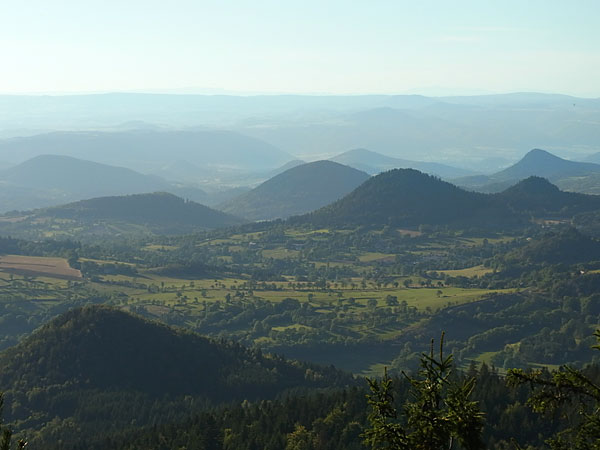
Robustness (2)
It seems as if I do not learn from my mistakes... In April 2011, my GXR with attached P10 unit and LC-2 lens cap fell a second time to the ground - this time during a walk at home. With a loud noise, it fell on the asphalt (from about 1m) hitting heavily the right bottom corner. Again, it survived, but this time with more "injuries":
- It has severe scratches at the corner (see first and second photo), and
- the small plastic part holding the battery in its place broke (see third photo)
Once again, the neckstrap got loose on one side, and again, the camera was off, and thus the lens protected.
This time, I exchanged body parts (which also "healed" the battery compartment). See below for the results.
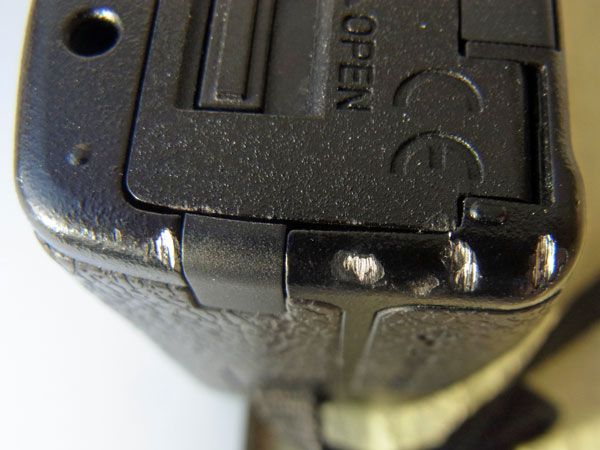
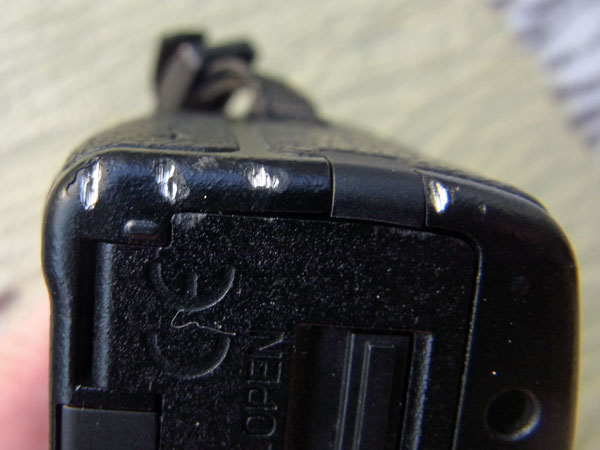
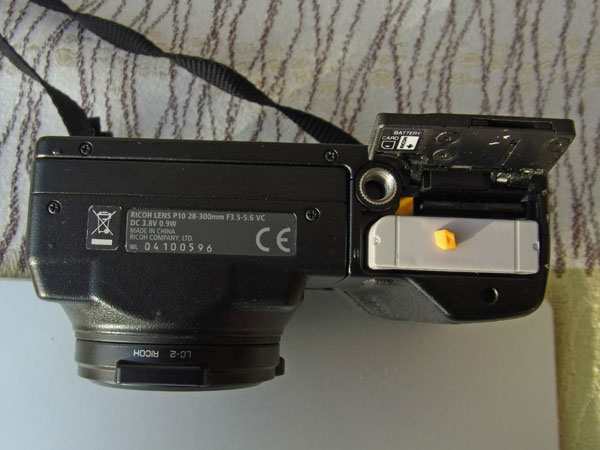
The following photo indicates what happened (click image for German version):
This photo indicates that there is a small issue with fixing the neck strap to the body (click image for German version):
Proposal for a Fix
Here is a "prototypical" proposal for a fix - a stopper that is attached to both ends of the neck strap (click image for German version):
Repair
As the body and P10 camera unit still worked well, I used the camera after Easter and sent both the body and the P10 to Pirmasens for repair/check in mid May. I sent both on a Monday and got the P10 back the next Friday - not bad! For the body, two cover parts had to be exchanged, which were not in stock. So I had to wait until June 1st before the body was returned to me. Not too bad! And all this for a flat rate of 45 Euros - no reason to complain, either.
My RICOH contact Mr. Wutzke offered me a loan body for the time that mine was in repair. First, I hesitated, but when it looked as if I would have to wait longer, I asked him to send me one. He did so, but in the meantime the cover parts also arrived at Pirmasens, and loan body and my own body arrived on the same day.
In the meantime, the loan body is on its way back to Mr. Wutzke who supported me all the time. Thanks a lot!
Preliminary Conclusions
I bought the GXR and some equipment for a lot of money and expanded it over the years. Overall, I am quite satisfied with it (to avoid cognitive dissonance...) and will, of course, keep it - hopefully - for a longer period of time, although there were moments when I considered getting rid of it (before firmware update 1.29).
In my opinion, Ricoh could indeed have done better regarding the AF speed and accuracy, particularly for the A12-50, and it took about a year until these issues were settled to some degree (I would not say, completely...). There were also some initial issues that are typical for new cameras. Ricoh should have eliminated these issues from the beginning, as the conditions under which they occurred were not that esoteric. But, we have become used to being users of banana software and products, and hopefully these issues can be ironed out in an upcoming firmware update.
All in all, the Ricoh GXR is definitely an adventure and demanding. It has to be mastered - but that's what makes it interesting and attractive for me.
| 19.11.2020 |
